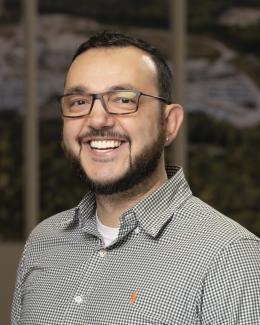On the grounds of the University of Maine’s Advanced Structures and Composites Center sits the nation’s first additively manufactured home made entirely from biobased materials - BioHome3D. The 600-square-foot home, the result of a collaboration between Oak Ridge National Laboratory and UMaine, is serving as a testbed to see how well the materials perform over time in the Northeastern climate. If environmental analysis, weatherization testing and energy data gathering conducted are favorable, the home could lead to the printing of thousands more like it, providing an energy efficient and economical housing alternative in the United States.
While BioHome is located thousands of miles away from ORNL, the foundational research that led to its completion began at the Department of Energy’s Manufacturing Demonstration Facility at the lab. The house, which was co-developed by ORNL and UMaine researchers, traces back to a bamboo-based 3D-printed pavilion showcased in Miami in 2016.
“We were asked by a New York-based architectural firm to print large-scale components for a pavilion for a design exposition – and they wanted the pavilion to be made from environmentally friendly material,” said Soydan Ozcan, an ORNL materials scientist who leads research with UMaine. “We chose bamboo.” The result, he said, was more than 10,000 pounds of material printed on the Big Area Additive Manufacturing printer which formed the supporting structure and the arms that served as seating for the large pavilion.
“The first step we took on that project was to begin compounding bamboo in the lab to make pellets, just in small batches at first,” he said. “This was also the first time a bioderived or biobased material was used for a large-scale additive manufacturing application.”
New materials lead to new partnership
Ozcan and fellow materials scientist Halil Tekinalp engineered the bamboo with polyactic acid, or PLA, a bioderived and biodegradable thermoplastic polyester also known as a bioplastic. The mixture contained about 20% bamboo and 80% PLA with the printed product containing similar properties as wood, including recyclable characteristics. The formulation worked and produced sturdy parts for the pavilion that could withstand the hot and humid Florida climate as well. It also led to the research team thinking about additional bioderived materials that could be compounded and printed to make other large-scale components for applications such as boats and houses.
“We were investigating formulations for different materials and around that time the University of Maine was also interested in developing bioderived materials,” Ozcan said. “We started a pilot program with Maine to focus on this work and that eventually led to printing a mold for the rooftop, the actual roof for a yacht, in 2019.”
Made from wood flour, cellulose nanofibrils and PLA, the yacht top marked the first research collaboration between ORNL and UMaine and the establishment of the first large-scale biobased additive manufacturing program in the U.S. to connect regional industry and university clusters with national lab resources. The collaboration that led to the yacht component – since named the Hub & Spoke Program – was formed following the closure of five paper mills in Maine in 2015. During a visit by ORNL researchers to the UMaine campus as part of an economic development assessment, participants from both organizations came up with the idea to find a new use for those resources previously needed by paper mills – the forest-derived materials – and use them for 3D printing applications.
Printing houses to relieve the housing crunch
Ozcan said the boat component led naturally to discussion about printing much larger objects. While 3D printing a house of bioderived materials had always been seen as a future possibility, the U.S. housing shortage sparked an urgent need to move forward.
“Maine, in addition to experiencing the shutdown of paper mills, is also impacted by a lack of affordable housing,” he said. Current estimates nationwide put the shortage of homes at 5.5 million - and counting. “It’s not just the shortage of houses, but skilled labor to build them, too,” Ozcan added. “This drives the need for automated and digitized construction, and additive manufacturing with new materials.”
ORNL worked with UMaine researchers to produce the home from novel biobased materials. It’s different from other commercially available 3D printed houses because it was made using fully biobased feedstock, each 100% additively manufactured in modules including the floors, walls and roof. The home was printed at UMaine on a single continuous print path using the world’s largest 3D printer, the Ingersoll Masterprint. Early research on the Ingersoll’s development was conducted at ORNL in the Manufacturing Demonstration Facility.
Over the next two years, researchers will collect data on the home to further prove that it’s a viable construction alternative. “We have sensors that simulate as if someone is living in the house,” he said. “This will help inform what we design next; we can look at more materials for walls and look at printing multi-level homes and integrate energy-efficient equipment so that the home emits no carbon dioxide emissions in all ways. Eventually we can build net-zero communities.”
Ozcan said the home’s recyclability means that if it is torn down, the materials could be reused again and again to make parts for other products. The home contributes to what is known as a circular economy in which a resource is continually reused rather than discarded as waste.
While the research home took several months to build, Habib Dagher, UMaine’s executive director for the Advanced Structures and Composites Center, said the overall project goal is to speed up the pace of manufacturing.
“We want to be able to print one home every two days, for example,” he said. “Eventually, we would produce homes from a single manufacturing line, ultimately making a difference in the housing availability. And, the more homes that can be manufactured, the greater the cost savings too.”
The project was funded by the U.S. Department of Energy’s Office of Energy Efficiency and Renewable Energy’s Advanced Manufacturing Office, now the Advanced Materials and Manufacturing Technologies Office and the Industrial Efficiency and Decarbonization Office.
ORNL is managed by UT-Battelle for DOE’s Office of Science, the single largest supporter of basic research in the physical sciences in the United States. DOE’s Office of Science is working to address some of the most pressing challenges of our time. For more information, visit energy.gov/science.






